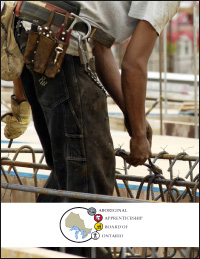Paving the way for successful careers in skilled trades
By Cheryl Long
The need for skilled labour across Canada continues to grow, and more than one group believes that the answer lies among the country’s aboriginal population. By increasing the number of First Nations, Métis and Inuit people working in skilled trades, there’s an opportunity to improve the socio-economic status of entire communities while solving the challenge of labour shortages nation-wide.
The Aboriginal Apprenticeship Board of Ontario (AABO) is one of those groups. The not-for-profit organization is singlehandedly run by executive director Sara Monture, who is working to ensure that the recommendations in “Supply Meeting Demand”, the document behind Ontario’s aboriginal Strategy, are included in a plan of action designed to increase the number of aboriginal people working in trades in Ontario. Members include Aboriginal Skills and Employment Training Strategy (ASETS) agreement holders and representatives of the Partnership Advisory Committee (PAC), representing government, industry and employers. AABO is the only association of its kind in Canada but given the interest industries are showing in hiring skilled aboriginal trades people, Monture expects similar groups to eventually form in other provinces.
“The aboriginal population is the youngest and fastest-growing in Canada. (Hiring aboriginal employees) makes sense as people retire, as skills gaps are identified … it’s a natural, made-in-Canada solution as opposed to looking at foreign labour,” she said. In return, a skilled trade represents the beginning of a well-paying career that can have a positive impact on their family and the aboriginal community as a whole. “It’s a chance to be successful (and) if you get into a unionized situation, you’re looking at pension and benefits.”
Encourage employment in skilled trades
In November, AABO hosted their fifth annual conference in Niagara Falls, Ontario, organized to highlight the need for partnerships that could help encourage more aboriginal people to enter skilled trades. The conference was the second for Monture, who joined AABO less than three years ago after working for the federal government and serving as a member of the board of directors for Grand River Employment and Training in Ohsweken, Ont.
The organization’s history goes back to 2006 when a working group was formed to help forge a connection between industry and ASETS holders. In 2007, the working group became more formally known as AABO and began its mission to act as a central point of contact between the two parties, endeavouring to increase the number of aboriginal people working in trades by improving access and opportunity to apprenticeship and employment.
Similar to any employment agency, ASETS holders help prospective workers prepare to enter the workforce. They may help them upgrade their academic levels, brush up on life skills or prepare for a job interview. Unions and employers benefit by receiving job prospects that have already been screened and have the skills necessary to do the job.
“It saves the union or the employer or the contractor time,” Monture explained. “That relationship is there. They know that if someone comes from (an ASETS holder), they’re going to be good.”
AABO building strong partnerships
That’s where AABO comes in, fostering those connections between employers and the ASETS holders who deliver aboriginal labour market programs. There are currently 18 agreement holders across Ontario, Monture said, that cover every First Nations, Métis or Inuit person in the province.
Learning a trade through apprenticeship also has a traditional component to it. “How did we learn to hunt, to fish, to learn which plants to use as medicine?” Monture pointed out. “Apprenticeship is traditional.”
There is an “increased appetite” for hiring aboriginal workers among Ontario industry, Monture said. The jobs are there but filling those means eliminating some of the barriers to education and employment that aboriginal communities face. The most common ones include a lack of education or not meeting a program’s educational requirements, transportation to either school or jobs and a willingness to leave their communities to follow the work. In a family that has been exposed to jobs in various trades sectors, those barriers aren’t as prominent but for those who have never left their communities, the prospect can be daunting.
“In remote areas far north, they hunt, they fish. Now they’re being taken from that,” she explained. Leaving an aboriginal community, moving into a large city and adjusting to something as seemingly simple as a different diet can make the experience difficult.
New portal to connect students with mentors
Those challenges are part of the reason AABO is embarking on a new project scheduled to launch next April. A new web portal accessible through AABO’s site will aim to connect prospective or new apprentices with mentors who can provide support, whether it be as simple as answering a few questions or helping with the adjustment to a strange new lifestyle. Eventually, Monture hopes to add a database to the site where contractors bidding on jobs can determine the trade capacity in a particular area.
Education and awareness will also play a key role in breaking down barriers. Those who are reluctant to leave their communities for an extended length of time may be interested in camp jobs where they’re away for three weeks and home for one. In other cases, it might mean that certain trades offer specialized courses that help prepare for exams. “It’s not about lowering requirements; it’s about working with us so we can get our people to meet those requirements,” Monture said.
In the meantime, Monture is busy working to raise AABO’s profile by connecting with industry partners and participating in speaking engagements. Down the road, she would like to see AABO operating as a national organization with a chapter in every province. For the aboriginal community, the goal is to continue to foster partnerships that will lead to the advancement of aboriginal Canadians working in the skilled trades.
“With all of the infrastructure investment, it’s only going to increase (the need for skilled trades). Not only does it make good business senses, it’s the right thing to do. I truly do see industry recognizing that.”







